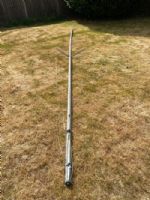Wind Weight |
Post Reply 
|
Page <123> |
| Author | ||
Scooby_simon 
Really should get out more 
Joined: 02 Apr 04 Location: United Kingdom Online Status: Offline Posts: 2415 |
 Post Options Post Options
 Quote Quote  Reply Reply
 Topic: Wind Weight Topic: Wind WeightPosted: 24 Nov 05 at 9:47pm |
|
So Stefan, Sailing upwind your sail area pushes you "up wind". Nope. It is the pressure difference between the wind that goes around the front of the mast and sail(s) and the back of the mast and sail(s) that moves you up wind - i.e. you are "sucked" upwind as the wind goes slower around the front(windward) vs the back. Down wind, yes F = PressurexArea does have more of an impact, but most high performance boats are still "sucked" along downwind as the AW is forward of abeam. Edited by Scooby_simon |
||
|
Wanna learn to Ski - PM me..
|
||
 |
||
Stefan Lloyd 
Really should get out more 
Joined: 03 Aug 04 Online Status: Offline Posts: 1599 |
 Post Options Post Options
 Quote Quote  Reply Reply
 Posted: 25 Nov 05 at 7:25am Posted: 25 Nov 05 at 7:25am |
|
|
You seem to think I said something different to what I actually said. As you say, on anything but a run, the pressure difference arises because of the aerofoil effect of the sail. I never said otherwise. But if you think sail area doesn't come into it, try sailing upwind with a pocket-handkerchief and see how far you get. Why do you think yachts put up smaller sails upwind when it gets breezier? Force = pressure * area is just basic physics. Not opinion and not a subject for debate. Actually it is the definition of what pressure means. One pascal = 1N per square metre. Edited by Stefan Lloyd |
||
 |
||
Jon Emmett 
Really should get out more 
Joined: 15 Mar 04 Location: United Kingdom Online Status: Offline Posts: 988 |
 Post Options Post Options
 Quote Quote  Reply Reply
 Posted: 25 Nov 05 at 8:53am Posted: 25 Nov 05 at 8:53am |
|
|
Hmmm. I am going to sail in Weymouth this weekend good old cold North breeze, maybe if I am lucky with snow. Next week I sail in Brazil in around 30 degrees. Funny the wind speed will be about the same. It will be interesting to see if I feel noticeably less overpowered!!!
|
||
 |
||
Scooby_simon 
Really should get out more 
Joined: 02 Apr 04 Location: United Kingdom Online Status: Offline Posts: 2415 |
 Post Options Post Options
 Quote Quote  Reply Reply
 Posted: 25 Nov 05 at 11:24am Posted: 25 Nov 05 at 11:24am |
|
Yes sail area is VERY important because this controls the pressure difference between the front and back of the sail. This difference is a result of the difference in the speed of the air across the front and the back of the sail. So yes the density of the air is small factor(but as someone above explained with a worked example is was a small one for just simple "push") We then come to the point where we need to decide what the wind extra "push" in the wind can provide as "thrust" via the sails by creating greater low presure area behind the sail(s). So I agree that colder air is heavier - obvious. BUT how much effect does this really make ? how much more thrust(low pressure) do you get by running slightly denser air around the sails. I don't know how to calculate this and IMO it's going to be almost not worth worrying about. Yes cold air is going to blow you over slightly harder when you are standing still (or sitting on the start line waiting to go). But once sailing along it will provide a litte more thrust (a very little). But not much. What we need is someone who's done an aeronautical degree(or somesuch) who knows the answer to this by calculcuting the differential lift if hot/cold air over a wing.....  |
||
|
Wanna learn to Ski - PM me..
|
||
 |
||
Stefan Lloyd 
Really should get out more 
Joined: 03 Aug 04 Online Status: Offline Posts: 1599 |
 Post Options Post Options
 Quote Quote  Reply Reply
 Posted: 25 Nov 05 at 12:54pm Posted: 25 Nov 05 at 12:54pm |
|
|
Well yes, and that would be me, as it happens. Mathematical modelling of flows over aircraft wings was precisely the area I specialised in during my first degree. I have already done the calculations you suggest earlier in this thread. To summarise, you will get more lift from colder air but I doubt the difference is noticeable in practice. Edited by Stefan Lloyd |
||
 |
||
yellowhammer 
Far too distracted from work 
Joined: 08 May 05 Location: United Kingdom Online Status: Offline Posts: 270 |
 Post Options Post Options
 Quote Quote  Reply Reply
 Posted: 25 Nov 05 at 12:56pm Posted: 25 Nov 05 at 12:56pm |
|
|
Aircraft cruise high (low dencity) and cold ... gives higher speed at design Mach No. for wing and reduced drag. Not sure it reads across to a 0.03 Mk No (20 kts) at sea level. Dencer air = more molecules in contact with sail = more drag, another factor to consider. |
||
|
Laser 3000 @ Leigh & Lowton SC
www.3000class.org.uk |
||
 |
||
Scooby_simon 
Really should get out more 
Joined: 02 Apr 04 Location: United Kingdom Online Status: Offline Posts: 2415 |
 Post Options Post Options
 Quote Quote  Reply Reply
 Posted: 25 Nov 05 at 1:29pm Posted: 25 Nov 05 at 1:29pm |
|
Excellent.
What I was trying to say is that the few degrees of them and thus density of the air was not really worrying about. |
||
|
Wanna learn to Ski - PM me..
|
||
 |
||
Entyplod 
Newbie 
Joined: 24 Nov 05 Location: United Kingdom Online Status: Offline Posts: 4 |
 Post Options Post Options
 Quote Quote  Reply Reply
 Posted: 26 Nov 05 at 4:08pm Posted: 26 Nov 05 at 4:08pm |
|
|
Redback asks what difference moisture makes the the density of air. The answer is actually the oppopsite to what one would think - moist air has a lower density than dry air. Odd, but true - and here is the boring mathematical bit to prove it (remember Gas Equation from school): Density = Pressure/RxTemperature R= Gas constant, which for water vapour is 1.6 times dry air. Hence density of moist air less than that of dry air. |
||
 |
||
Scooby_simon 
Really should get out more 
Joined: 02 Apr 04 Location: United Kingdom Online Status: Offline Posts: 2415 |
 Post Options Post Options
 Quote Quote  Reply Reply
 Posted: 26 Nov 05 at 4:10pm Posted: 26 Nov 05 at 4:10pm |
|
I knew that bit. Just did not want to complicate it any more for now..... |
||
|
Wanna learn to Ski - PM me..
|
||
 |
||
redback 
Really should get out more 

Joined: 16 Mar 04 Location: Tunbridge Wells Online Status: Offline Posts: 1502 |
 Post Options Post Options
 Quote Quote  Reply Reply
 Posted: 27 Nov 05 at 11:58pm Posted: 27 Nov 05 at 11:58pm |
|
|
I'm impressed by you guys.
|
||
 |
||
Post Reply 
|
Page <123> |
| Forum Jump | Forum Permissions  You cannot post new topics in this forum You cannot reply to topics in this forum You cannot delete your posts in this forum You cannot edit your posts in this forum You cannot create polls in this forum You cannot vote in polls in this forum |
Copyright ©2001-2010 Web Wiz
Change your personal settings, or read our privacy policy

























 Printable Version
Printable Version Delicious
Delicious Digg
Digg Facebook
Facebook Furl
Furl Google
Google MySpace
MySpace Newsvine
Newsvine reddit
reddit StumbleUpon
StumbleUpon Twitter
Twitter Windows Live
Windows Live Yahoo Bookmarks
Yahoo Bookmarks Topic Options
Topic Options
